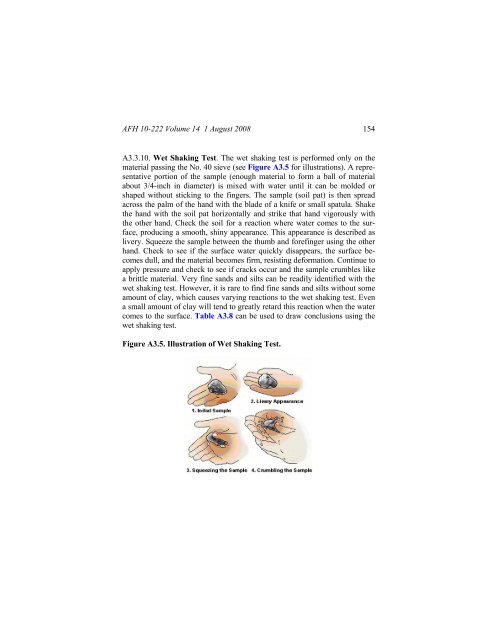Civil engineer guide to fighting positions, shelters, obstacles
Civil engineer guide to fighting positions, shelters, obstacles
Civil engineer guide to fighting positions, shelters, obstacles
You also want an ePaper? Increase the reach of your titles
YUMPU automatically turns print PDFs into web optimized ePapers that Google loves.
AFH 10-222 Volume 14 1 August 2008 154<br />
A3.3.10. Wet Shaking Test. The wet shaking test is performed only on the<br />
material passing the No. 40 sieve (see Figure A3.5 for illustrations). A representative<br />
portion of the sample (enough material <strong>to</strong> form a ball of material<br />
about 3/4-inch in diameter) is mixed with water until it can be molded or<br />
shaped without sticking <strong>to</strong> the fingers. The sample (soil pat) is then spread<br />
across the palm of the hand with the blade of a knife or small spatula. Shake<br />
the hand with the soil pat horizontally and strike that hand vigorously with<br />
the other hand. Check the soil for a reaction where water comes <strong>to</strong> the surface,<br />
producing a smooth, shiny appearance. This appearance is described as<br />
livery. Squeeze the sample between the thumb and forefinger using the other<br />
hand. Check <strong>to</strong> see if the surface water quickly disappears, the surface becomes<br />
dull, and the material becomes firm, resisting deformation. Continue <strong>to</strong><br />
apply pressure and check <strong>to</strong> see if cracks occur and the sample crumbles like<br />
a brittle material. Very fine sands and silts can be readily identified with the<br />
wet shaking test. However, it is rare <strong>to</strong> find fine sands and silts without some<br />
amount of clay, which causes varying reactions <strong>to</strong> the wet shaking test. Even<br />
a small amount of clay will tend <strong>to</strong> greatly retard this reaction when the water<br />
comes <strong>to</strong> the surface. Table A3.8 can be used <strong>to</strong> draw conclusions using the<br />
wet shaking test.<br />
Figure A3.5. Illustration of Wet Shaking Test.
















